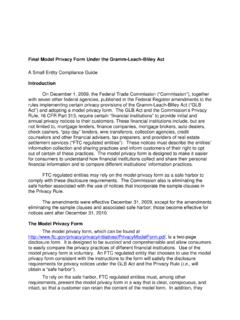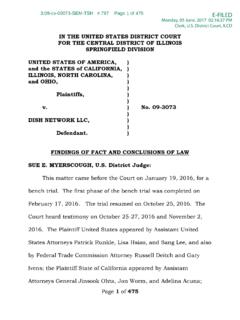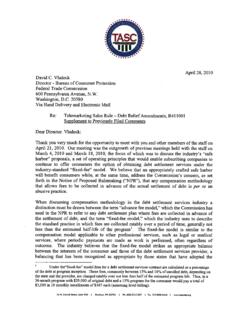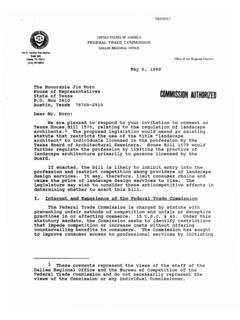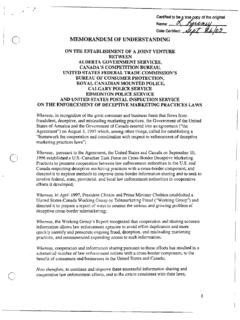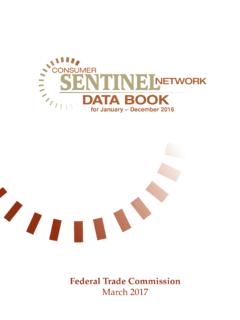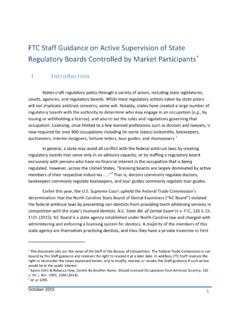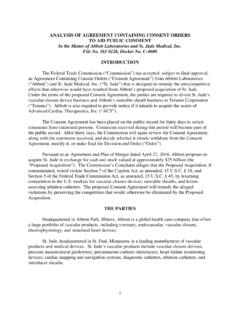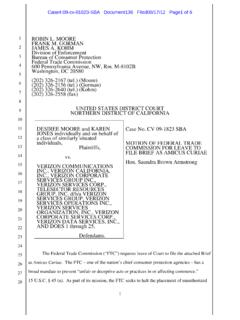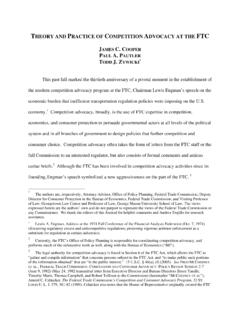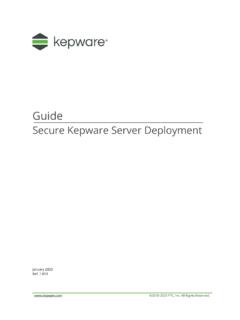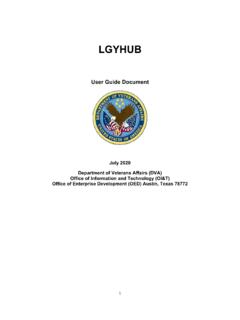Transcription of CYBERSECURITY BASICS - Federal Trade Commission
1 CYBERSECURITY FORSMALL BUSINESSLEARN MORE BASICSC yber criminals targetcompanies of all some CYBERSECURITY BASICS and putting them in practice will help you protect your business and reduce the risk of a cyber FILES & DEVICESU pdate your softwareThis includes your apps, web browsers, and operating systems. Set updates to happen your filesBack up important files offline, on an external hard drive, or in the cloud. Make sure you store your paper files securely, passwordsUse passwords for all laptops, tablets, and t leave these devices unattended in public devicesEncrypt devices and other media that contain sensitive personal information. This includes laptops, tablets, smartphones, removable drives, backup tapes, and cloud storage multi-factor authenticationRequire multi-factor authentication to access areas of your network with sensitive information. This requires additional steps beyond logging in with a password like a temporary code on a smartphone or a key that s inserted into a computer.
2 LEARN MORE FORSMALL BUSINESSPROTECTYOUR WIRELESS NETWORKS ecure your routerChange the default name and password, turn off remote management, and log out as the administrator once the router is set at least WPA2 encryptionMake sure your router offers WPA2 or WPA3 encryption, and that it s turned on. Encryption protects information sent over your network so it can t be read by BUSINESS AS USUALSMART SECURITYR equire strong passwordsA strong password is at least 12 characters that are a mix of numbers, symbols, and capital lowercase reuse passwords and don t share them on the phone, in texts, or by email. Limit the number of unsuccessful log-in attempts to limit password-guessing all staffCreate a culture of security by implementing a regular schedule of employee training. Update employees as you find out about new risks and vulnerabilities. If employees don t attend, consider blocking their access to the a planHave a plan for saving data, running the business, and notifying customers if you experience a breach.
3 The FTC s Data Breach Response: A guide for Business gives steps you can take. You can find it at MORE FORSMALL BUSINESSLEARN MORE NIST CYBERSECURITY FRAMEWORKYou may have heard about the NIST CYBERSECURITY Framework, but what exactly is it?And does it apply to you? NIST is the National Institute of Standards and Technology at the Department of Commerce. The NIST CYBERSECURITY Framework helps businesses of all sizes better understand, manage, and reduce their CYBERSECURITY risk and protect their networks and data. The Framework is voluntary. It gives your business an outline of best practices to help you decide where to focus your time and money for CYBERSECURITY can put the NIST CYBERSECURITY Framework to work in your business in these five areas: Identify, Protect, Detect, Respond, and Recover. 1. IDENTIFYMake a list of all equipment, software, and data you use, including laptops, smartphones, tablets, and point-of-sale and share a company CYBERSECURITY policy that covers:2.
4 PROTECT Control who logs on to your network and uses your computers and other devices. Use security software to protect data. Encrypt sensitive data, at rest and in transit. Conduct regular backups of data. Update security software regularly, automating those updates if possible. Have formal policies for safely disposing of electronic files and old devices. Train everyone who uses your computers, devices, and network about CYBERSECURITY . You can help employees understand their personal risk in addition to their crucial role in the and responsibilities for employees, vendors, and anyone else with access to sensitive to take to protect against an attack and limit the damage if one FORSMALL BUSINESS3. DETECTM onitor your computers for unauthorized personnel access, devices (like USB drives), and your network for unauthorized users or any unusual activities on your network or by your RESPONDHave a plan for: Notifying customers, employees, and others whose data may be at risk.
5 Keeping business operations up and running. Reporting the attack to law enforcement and other authorities. Investigating and containing an attack. Updating your CYBERSECURITY policy and plan with lessons learned. Preparing for inadvertent events (like weather emergencies) that may put data at your plan RECOVERA fter an attack:Repair and restore the equipment and parts of your network that were employees and customers informed of your response and recovery more information on the NIST CYBERSECURITY Framework and resources for small businesses, go to and MORE FORSMALL BUSINESSLEARN MORE SECURITYC ybersecurity begins with strong physical security. Lapses in physical security can expose sensitive company data to identity theft, with potentially serious consequences. For example:An employee accidentally leaves a flash drive on a coffeehouse table. When he returns hours later to get it, the drive with hundreds of Social Security numbers saved on it is gone.
6 Another employee throws stacks of old company bank records into a trash can, where a criminal finds them after business hours. A burglar steals files and computers from your office after entering through an unlocked TO PROTECT EQUIPMENT & PAPER FILESHere are some tips for protecting information in paper files and on hard drives, flash drives, laptops, point-of-sale devices, and other equipment. Store securelyWhen paper files or electronic devices contain sensitive information, store them in a locked cabinet or physical accessWhen records or devices contain sensitive data, allow access only to those who need it. Send remindersRemind employees to put paper files in locked file cabinets, log out of your network and applications, and never leave files or devices with sensitive data unattended. Keep stockKeep track of and secure any devices that collect sensitive customer information. Only keep files and data you need and know who has access to FORSMALL BUSINESSHOW TO PROTECT DATA ON YOUR DEVICESA burglary, lost laptop, stolen mobile phone, or misplaced flash drive all can happen due to lapses in physical security.
7 But they re less likely to result in a data breach if information on those devices is protected. Here are a few ways to do that:Require complex passwordsRequire passwords that are long, complex, and unique. And make sure that these passwords are stored securely. Consider using a password multi-factor authenticationRequire multi-factor authentication to access areas of your network with sensitive information. This requires additional steps beyond logging in with a password like a temporary code on a smartphone or a key that s inserted into a computer. Limit login attemptsLimit the number of incorrect login attempts allowed to unlock devices. This will help protect against intruders. EncryptEncrypt portable media, including laptops and thumb drives, that contain sensitive information. Encrypt any sensitive data you send outside of the company, like to an accountant or a shipping service. YOUR EMPLOYEESTRAINI nclude physical security in your regular employee trainings and communications.
8 Remind employees to:Shred documentsAlways shred documents with sensitive information before throwing them data correctlyUse software to erase data before donating or discarding old computers, mobile devices, digital copiers, and drives. Don t rely on delete alone. That does not actually remove the file from the computer. Promote security practices in all locationsMaintain security practices even if working remotely from home or on business the response planAll staff should know what to do if equipment or paper files are lost or stolen, including whom to notify and what to do next. Use Data Breach Response: A guide for Business for help creating a response plan. You can find it at MORE FORSMALL BUSINESSLEARN MORE in your company gets an looks legitimate but with one click on a link, or one download of an attachment, everyone is locked out of your network. That link downloaded software that holds your data hostage.
9 That s a ransomware attackers ask for money or cryptocurrency, but even if you pay, you don t know if the cybercriminals will keep your data or destroy your files. Meanwhile, the information you need to run your business and sensitive details about your customers, employees, and company are now in criminal hands. Ransomware can take a serious toll on your ITHAPPENSC riminals can start a ransomwareattack in a variety of emails with links and attachments that put your data and network at risk. These phishing emails make up most ransomware can be exploited by websites that automatically download malicious software onto your ads that contain malicious code even on websites you know and FORSMALL BUSINESSHOW TO PROTECT YOUR BUSINESSHave a plan How would your business stay up and running after a ransomware attack? Put this plan in writing and share it with everyone who needs to up your data Regularly save important files to a drive or server that s not connected to your network.
10 Make data backup part of your routine business your security up to date Always install the latest patches and updates. Look for additional means of protection, like email authentication , and intrusion prevention software, and set them to update automatically on your computer. On mobile devices, you may have to do it your staff Teach them how to avoid phishing scams and show them some of the common ways computers and devices become infected. Include tips for spotting and protecting against ransomware in your regular orientation and TO DO IF YOU REATTACKEDL imit the damageImmediately disconnect the infected computers or devices from your network. If your data has been stolen, take steps to protect your company and notify those who might be the authoritiesReport the attack right away to your local FBI your business running Now s the time to implement that plan. Having data backed up will I pay the ransom?
